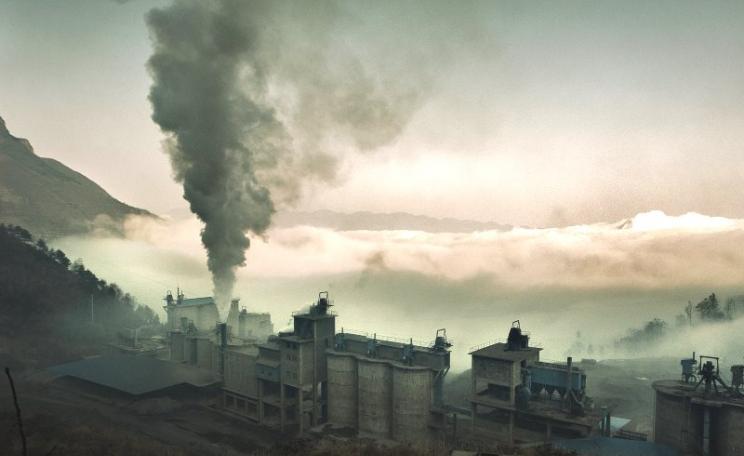First and foremost, moving to Ecopolis means creating urban systems that do not rely on fossil fuels.
“Our present civilisation is a giant motor car moving along a one-way street at an ever-accelerating speed," wrote Lewis Mumford. "As now constructed, the car lacks both steering wheel and brakes, and the only form of control the driver exercises consists in making the car go faster... He has quite forgotten the purpose of the journey.”
Sometime around the year 2000 a child was born who turned humanity into a predominantly urban species for the first time. This probably occurred in a megacity such as Lagos, Cairo, Manila or Dakar, or one of their smaller satellite cities.
The baby’s parents probably migrated there from a peasant village – driven away by droughts or floods, by soil erosion, pollution, or farm mechanisation, drawn to the city by the urgent hope of a little prosperity. A better life for their children.
Professor Herbert Girardet is a keynote speaker at the SMALL IS THE FUTURE event hosted by The Ecologist with the Schumacher Institute in Bristol on Saturday, 17 June 2023. Tickets are selling fast - a third have already gone - so do BOOK NOW to avoid disappointment.
Satellite
Humans, having transformed from hunter-gatherers into farmers or cattle herders, are now turning into concrete-jungle dwellers. All over the south, people continue arriving at bus or railway stations, carrying rolled-up mattresses, blankets and carrier bags, to try their luck in the city.
And so already overcrowded slums and squatter camps sprawl further across farmland or mangrove-clad lagoons, or up wooded slopes, with more people roaming the city streets in search of work.
Cities grow for a reason: they are centres of economic activity and, not surprisingly, rural migrants aspire to a share of the goodies they have to offer – bottled gas and kerosene, food supplies from global sources, and health and education services.
With a large spectrum of livelihood options, urban economies in the south are likely to further expand in the coming decades, drawing on so far untapped human and natural resources. But what are the long-term costs and benefits?
The new, sprawling urban landscapes that are emerging in developing countries are now frequently seen in satellite footage shown in TV documentaries. Urban growth – vertical and horizontal – is the most visible manifestation of the Anthropocene, this ‘age of the human’.
Heyday
First and foremost, moving to Ecopolis means creating urban systems that do not rely on fossil fuels.
But elsewhere we see shrinking forests, rivers brown with eroding soil, and factory trawlers sweeping the oceans.
Mines and quarries scar landscapes in unexpected places. But there is little serious discussion about the linkages between cities and their distant ‘sacrifice zones’, defined as geographic areas that have been “permanently impaired by heavy environmental alterations or economic disinvestment”.
In a world facing a climate emergency, some authors argue that, by packing large numbers of people into relatively small areas of land, cities are more energy efficient than low-density rural settlements.
But this does not hold true for cities in developing countries: here per capita energy use typically increases three or four times as rural-urban migrants gain access to fossil fuel energy for cooking, heating, air conditioning and transportation. Energy use in cities invariably rises with increasing wealth or gross domestic product per capita.
In contemplating an urbanising world, it may be useful to look back at the genesis of modern London. In 1800 it was the only city on Earth with over a million people, the size of Rome in its heyday 1,600 years earlier.
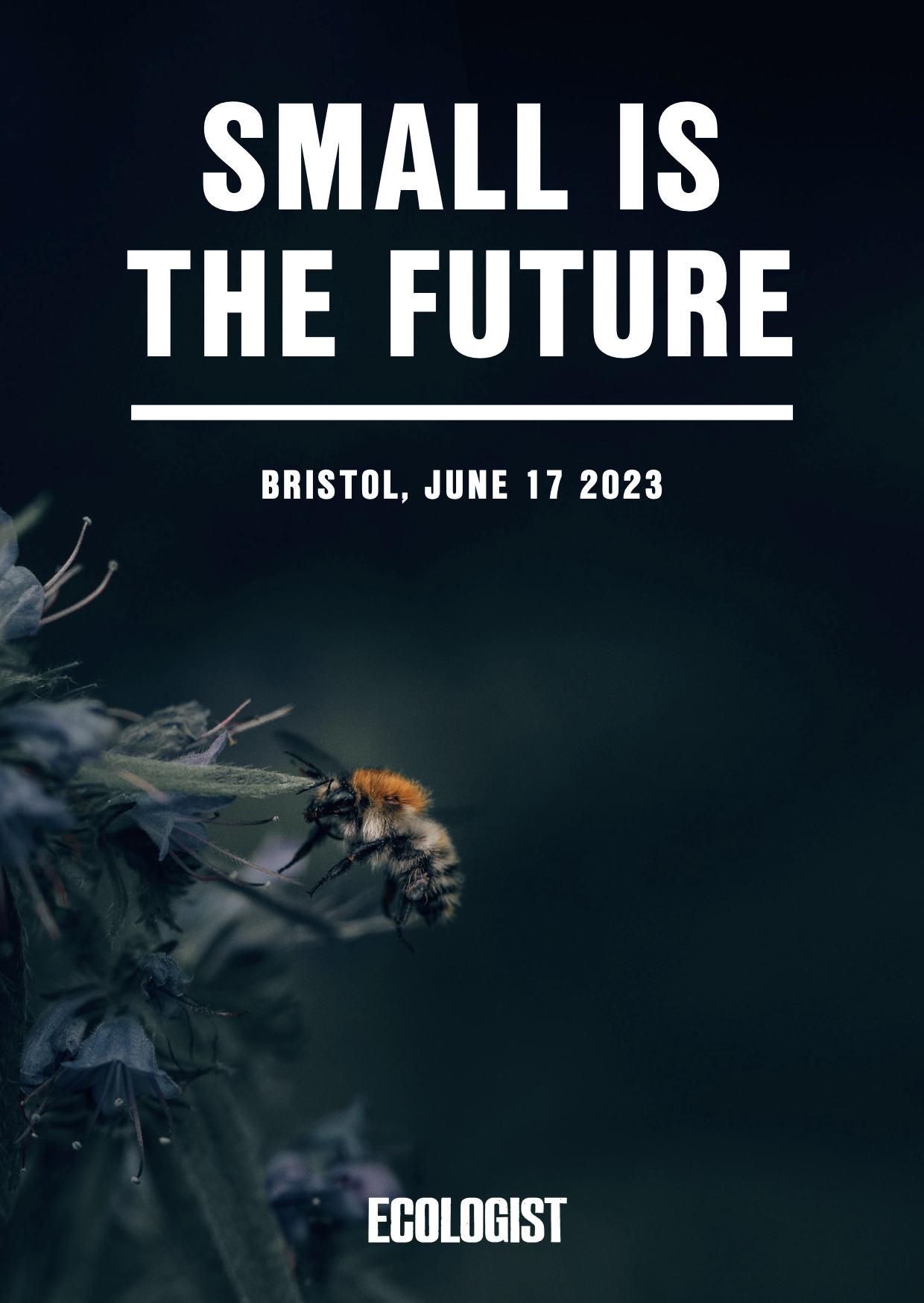
Sprung
From the late 18th century onwards, London pioneered a sort of ‘unsustainable urban development’, relying on ever more fossil fuel energy and global resource supplies.
Combustion technologies and global trade jointly fuelled its unprecedented growth from 1 million people in 1800 to over eight million people in 1939. London was now rooted globally in the forests, farmland and mines of the British empire.
London is a magnificent and popular city, with wonderful buildings and a throbbing multicultural life. Its museums, public parks and private gardens are famed across the world. It has nearly as many trees as people, and its outward growth is deliberately constrained by a green belt.
But environmental sustainability is not its strongest point. Just take energy: London requires three super-tankers of oil equivalent to meets its weekly energy needs. How much longer can this systemic dependence on non-renewable fossil fuels continue?
London set a pattern of urban growth that is being replicated across the world. In the 20th century, the urban age got seriously under way: since the Wirtschaftswunder years of the 1950s and 1960s, thousands of new cities of unprecedented size have sprung up, primarily in developing countries, often on the sites of existing villages and small towns.
Pollution
Under current trends, three-quarters of a human population of maybe 9 billion will be urban by 2050, yet few questions are being asked about how this could affect the long-term wellbeing both of the inhabitants of these cities and of the global environment.
London, as a global trading centre, helped stimulate the emergence of other megacities: Hong Kong, Delhi, Calcutta, Lagos, Johannesburg, Singapore, all of them part of Britain’s colonial empire.
Other global cities, such as New York, Tokyo, Los Angeles, São Paulo and Shanghai, have since been added to the list, and have recently been joined by Dubai and Abu Dhabi as major economic hubs.
The larger the city, the more likely it is to be also a major financial player, and the longer are its supply lines and its demands for natural resources. Whilst urban-centred communication, transport and trading systems connect humanity as never before, they are also causing ever-larger global ecological footprints and environmental externalities. More on this topic later.
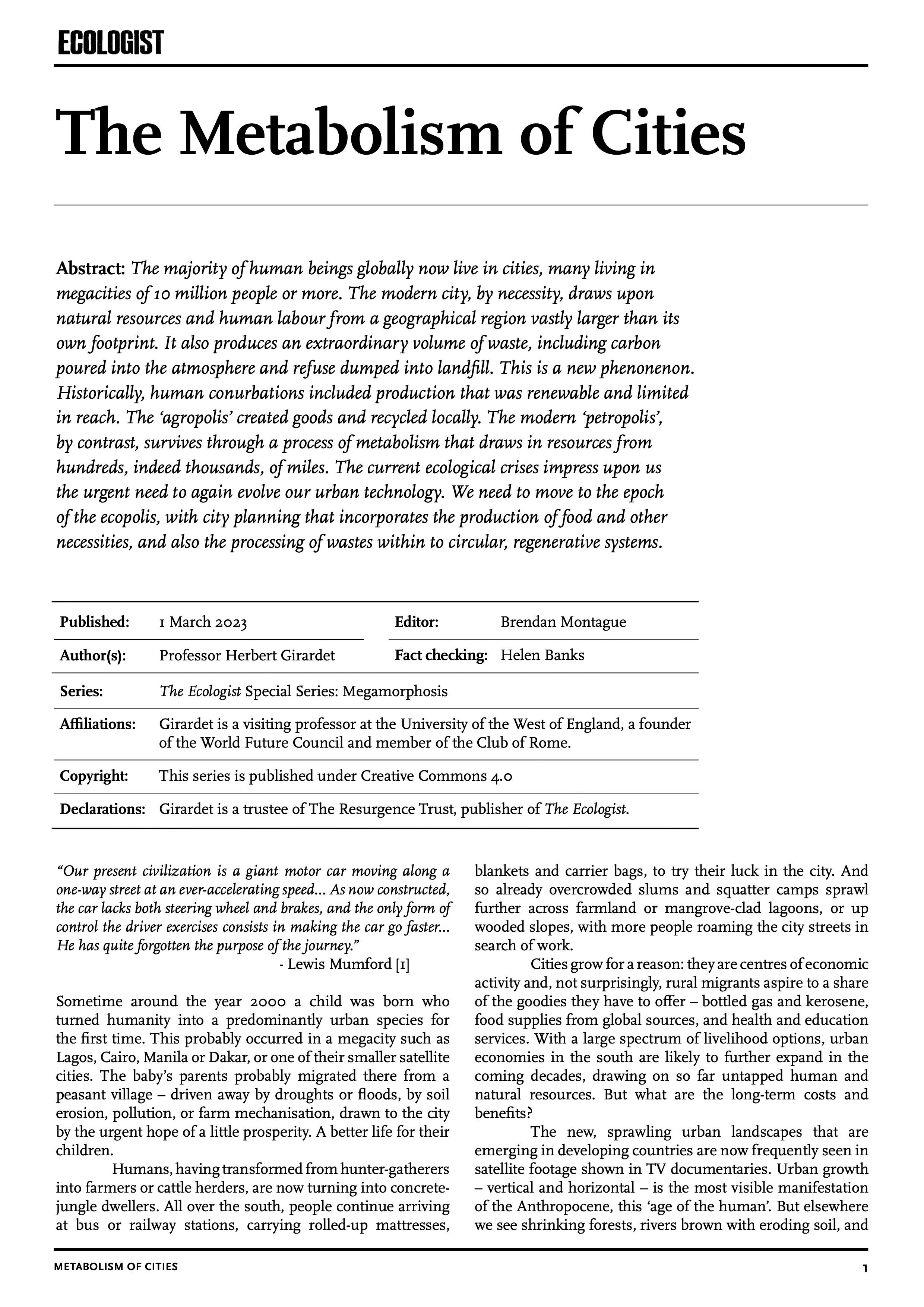
Techniques
UCL professor Mark Maslin has written much about the Anthropocene. He says: “Up until now, we have talked about things like climate change, the biodiversity crisis, the pollution crisis, as separate things…
"The key concept of the Anthropocene is to put that all together and say humans have a huge impact on the Earth, we are the new geological superpower. That holistic approach then allows you to say: ‘What do we do about it?’”
I would argue that in the ‘Earth emergency’ that is upon us, we must make it a top priority to get to grips with the metabolism of an urbanising world. Cities, as centres of production and consumption, slurp up the world’s natural resources, and spill out solid, liquid and gaseous wastes somewhere in Nature.
These are the externalities of urban systems, geographically laid out. If we want an urban future, we’d better find ways to redesign the metabolism of cities, while also making serious efforts to restore damaged ecosystems.
The good news is that, more than ever, city planners are engaged in lively exchanges across the world. They advise each other on creating efficient public transport systems, on techniques for reducing air pollution, on tree planting and urban agriculture.
Biosphere
They exchange policies for the rapid deployment of renewable energy, for recycling and remanufacturing urban wastes, and for the growth of new, green economies.
There is now wide recognition of the urgent need to safeguard local environments on which cities depend. But now we need to deepen global exchanges on how to get to grips with the detrimental, global impacts of cities, and that includes the urban metabolism.
Can modern cities find ways of curbing their enormous appetite for energy, food, timber and consumer goods, and their astonishing discharge of gaseous, liquid and solid wastes?
Can we create resource-efficient urban systems within the carrying capacity of planet Earth? Can the metabolism of modern cities ever become compatible with the biosphere? What measures could achieve such positive outcomes?
AGROPOLIS
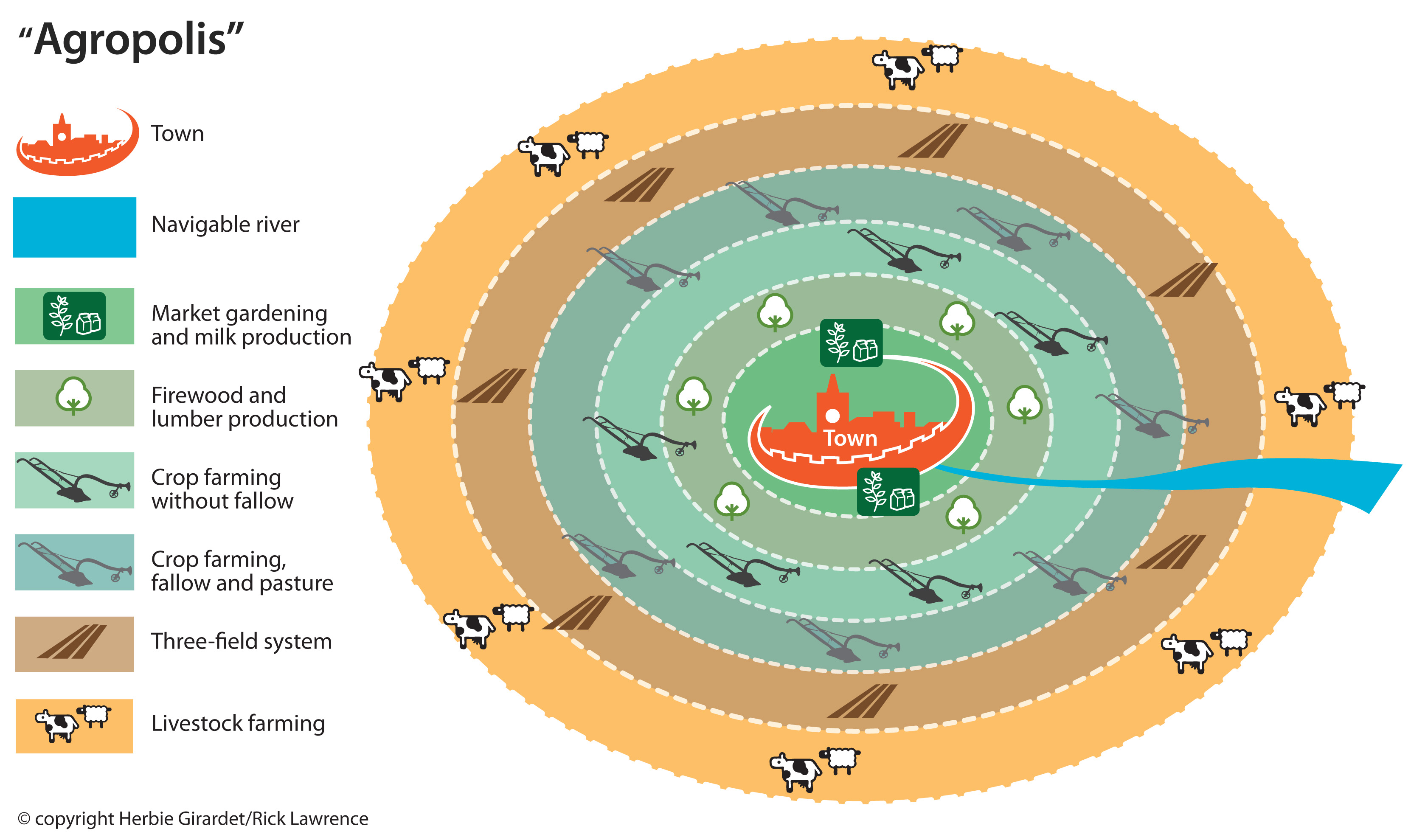
Where did all this start? In the mid-19th century, the German geographer and economist Heinrich von Thünen tried to understand how human settlements relate to their local environment.
In his book The Isolated State he drew a systemic diagram of urban–rural interdependence. He showed that in relative isolation, with limited transport access, villages and towns will assure a high degree of economic self-sufficiency, with food top of the agenda. They are invariably ringed by a series of ‘cropping circles’.
Market gardens, for year-round fruit and vegetable supplies, are located closest to the town. The next ring is the town forest: firewood and timber is best grown nearby because it is heavy.
And then further out, grains, root vegetables and fodder crops are grown. And beyond these fields, in the fourth ring, cows, horses, sheep and goats have their grazing. Manure from the animals is transported back to fertilise market gardens and field crops.
The whole system is powered by solar energy, with water and wind power also used in some places. The logic of this arrangement, prevalent before the introduction of canals, railway lines and tarmacked roads, is compelling.
Peri-urban
Some years ago, I visited a small German town called Dinkelsbühl, one of the few still surrounded by a completely intact wall. The town was still ringed by thriving market gardens.
Every night, I saw cows being herded into town from outlying pastures, to be milked in stables within the town walls. In the morning they were herded out to graze again.
The town itself is an arrangement of narrow lanes with names listing the various professions that prevail: bakers, carpenters, blacksmiths, brewers, dressmakers, chandlers, shoemakers have their workshops and dwellings in multi-storey terraced houses. A central marketplace is set next to church, town hall and alehouse.
Von Thünen’s scheme has been applied by geographers in many locations. In Chinese cities, peri-urban agriculture was common practice until recently, and in some places it still plays an important role, despite the pressures of industrial and suburban growth.
Superfluous
Even in megacities such as Shanghai, some peri-urban land is still safeguarded by the city authorities to secure local supplies of vegetables, fruit, meat and pond fish.
And until recently, night soil was routinely used for fertilising food crops. But with the introduction of piped sewerage systems, most is now flushed away, merging with artificial fertilisers (and pesticides) in rivers and coastal waters. Can new ways of closing the nutrient cycle be found?
By and large, Agropolis, the town embedded in a local, productive landscape, is well on its way to becoming a historical relic.
Local food systems are giving way to globalised supplies, with food being shipped, trucked and flown into town from all over the world. And the timber needs of an urbanising world are met from faraway forests, as firewood has become largely superfluous.
LIVING IN PETROPOLIS
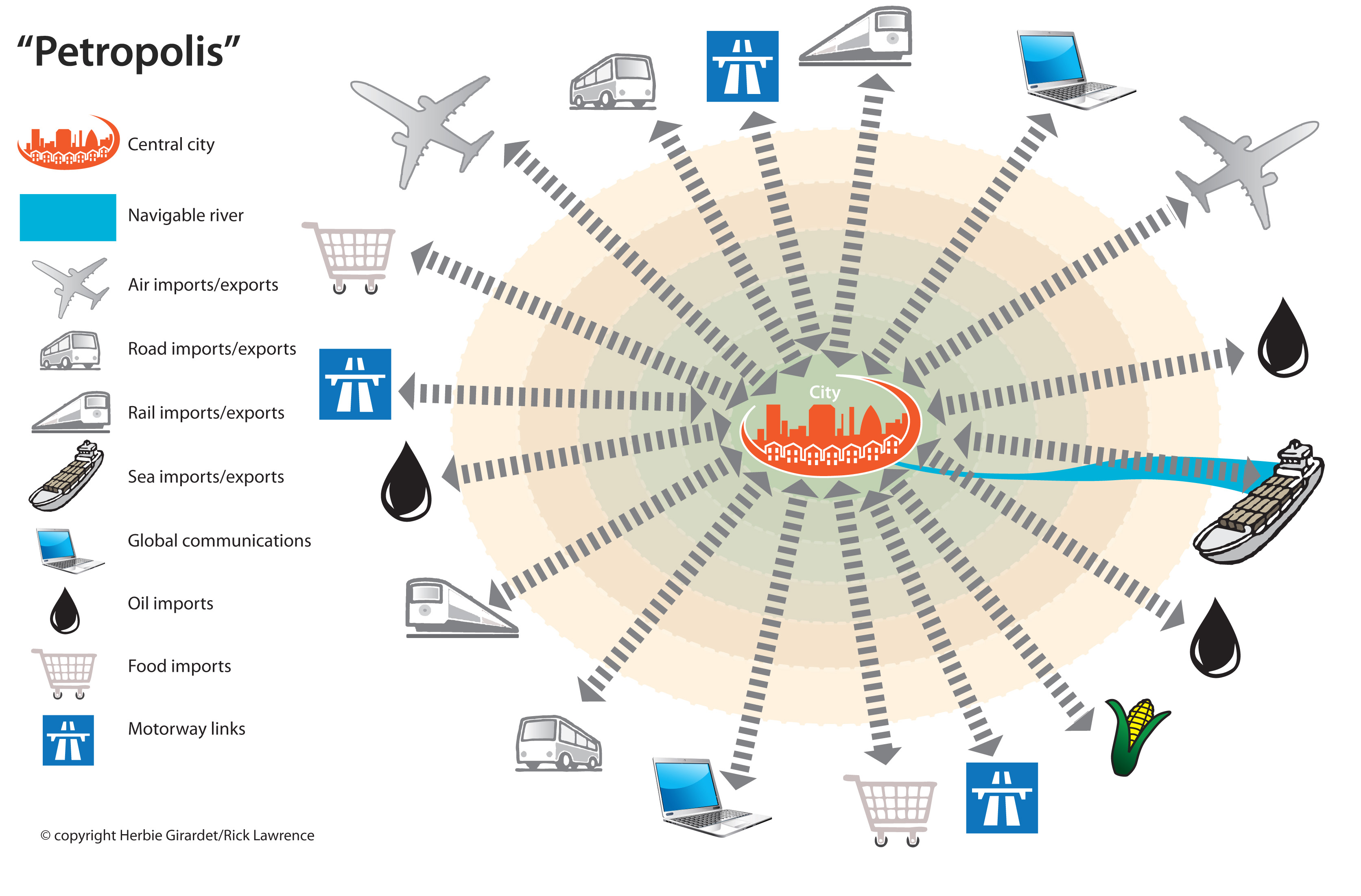
Today, of course, we do not live in Agropolis, but in Petropolis, where the services provided by oil, gas and coal technology are seen as non-negotiable. Petropolis has become our new home, relying on daily injections of ‘ancient sunshine’ stored in the Earth’s crust over hundreds of millions of years.
Cities today take up three to four per cent of the world’s land surface, but they transcend local geographical boundaries, with tentacles stretching across the world to access resources.
As modern city people, what would we do without power stations, central heating boilers, locomotives and vehicle engines? Without electric sockets for our computers, TVs and washing machines?
Or without container ports and airports? Could we exist without quarries and mines, or cement and steel works? Could we feed ourselves without food being brought in from somewhere far away?
A recent McKinsey report says this: “The world is in the throes of a sweeping population shift from the countryside to the city. Underpinning this transformation are the economies of scale that make concentrated urban centers more productive.
Inhabitants
"This productivity improvement from urbanization has already delivered substantial economic growth and radically reduced poverty in countries such as China. The growth of cities has the potential for further growth and poverty reduction across many emerging markets.”
There has been much talk about the ‘triumph of the city’, linked to unprecedented economic growth. Cities are the heart of what Lewis Mumford calls ‘carboniferous capitalism’, fossil-fuel-powered wealth creation and accumulation.
Cities are where things are made and consumed. As economic centres, they harbour extremes of wealth and poverty. And invariably the urban poor also suffer the worst environmental degradation – stinking rubbish tips, polluted air, rivers full of plastic waste.
The emergence of Petropolis represents a historic systemic change in the relationship between humans and Nature.
Cities with populations of 10 to 20 million people are becoming commonplace as the hubs of growing national economies. And city regions with up to 100 million inhabitants are on the drawing boards of planning offices. Can all this happen without oil, coal and gas? Or are there limits to fossil-fuelled urban growth?
Precipitation
Modern cities are vastly complex, interactive systems designed to turn energy into work or motion, flowing along roads, rails, wires and pipes.
Cities function as giant heat engines that are subject to entropy: fuels can be burned only once, and invariably they end up as low-grade heat and waste gases. And as raw materials are processed, their quality inevitably deteriorates.
Order, established in the form of neat, built-up urban landscapes, causes disorder elsewhere in Nature. Concentrating human activities in high-energy cities thus increases entropy – waste and pollution – for the planet as a whole, raising major questions about the long-term viability of our cities. Is there a future for Petropolis?
The UN’s agency on urban futures, UN Habitat, states this: “Urban areas are major contributors to climate change, accounting for 71 to 76 per cent of CO2 emissions from global final energy use, and represent high concentrations of financial, infrastructure and human assets and activities that are vulnerable to climate change impacts.
"In the coming decades, hundreds of millions of people in urban areas are likely to be affected by rising sea levels, increased precipitation, inland floods, more frequent and stronger cyclones and storms, and periods of more extreme heat and cold.”
Enriched
These are troubling sentences. We need new tools to weigh up the costs and benefits of urban and mega-urban development, and to assess how urban systems could successfully coexist with the biosphere.
Currently cities have an essentially linear, uni-directional metabolism, with a huge variety of resources flowing through the urban system without much concern about their origin, or about the destination of wastes. Inputs and outputs are treated as largely unconnected.
Fossil fuels are extracted from rock strata, refined and burned, with waste gases being dumped in the atmosphere. Raw materials are extracted, processed and assembled into consumer goods that ultimately end up as polluting trash. In distant forests, trees are felled for their timber or pulp, but all too often forests are not replenished.
Similar concerns apply to the urban food system: nutrients and carbon are removed from farmland as crops are harvested, processed and eaten. The resulting sewage, with or without treatment, ends up in rivers and coastal waters, and the plant nutrients it contains are rarely returned to farmland any longer.
Rivers and coastal waters the world over are ‘enriched’ by a potent mix of urban sewage and toxic effluents, as well as mineral fertilisers and pesticides leaching from the farmland used for feeding cities.
Emissions
The local effects of urban resource use also need to be better understood. Cities accumulate large amounts of materials. For instance, Vienna, with about 2 million inhabitants, increases its actual weight by some 25,000 tonnes every day.
Much of this is relatively inert materials, such as steel, concrete and tarmac. Other substances, such as heavy metals, leaching from the roofs of buildings and from water pipes, also accumulate in the local environment.
Nitrates, phosphates and various chemicals accumulate in urban soils and watercourses, impacting the health of present and future inhabitants.
Of course, cities are – above all else – meant to facilitate human interaction, with a huge variety of occupations adding up to a very complex division of labour and a diverse cultural scene. But at what cost?
In understanding modern cities, we also need to assess their ecological footprint (EF): the surface areas required for food and timber supplies, and for sequestering urban carbon emissions.
Compact
In 1999 I undertook an analysis of London’s metabolism for the Greater London Authority. The input–output figures I compiled also allowed me to calculate London’s ecological footprint. I estimated that it extended to no less than 125 times London’s territory!
But my figures were in fact incomplete: they did not include food waste, or the land and sea surfaces needed to supply pet food and fish. A more comprehensive study, by Best Foot Forward Ltd. in 2002, found that London’s total EF extended to 293 times its territory, or 49 million ‘global hectares’: twice the area of the UK, or roughly the same size as Spain.
London has about 12 per cent of the UK’s population. What about the EF of Birmingham, Liverpool, Manchester, Bristol, Cardiff and the UK’s many smaller cities and towns? What does the EF of the whole of the country, with an 84 per cent urban population, extend to? And where are all these external surfaces located?
It is often argued that in the rather compact cities of Europe, the footprints of city people tend to be smaller than those of their rural cousins, who use private cars much more.
Global
But in countries such as China and India different realities prevail: rural people there live more frugally, and when they move to cities their per capita resource consumption typically goes up fourfold: the move tends to improve their living standard, and with that, their use of the Earth’s resources.
This has important implications for urban planning: to get a clearer perspective of the environmental ‘performance’ of cities, balance sheets comparing urban resource flows are gradually becoming available.
It is becoming evident that similar-sized cities supply people’s needs with a greatly varying throughput of resources, but much more research is needed for a comprehensive, global picture.
The case of China is particularly pertinent here: with a population of 1.4 billion people, anything that China does is of global significance. Probably none more so than the multiple impacts of its urbanisation.
Timescale
After Mao Zedong’s death in 1976, urban-economic growth turned China into the world’s workshop. This development was intimately linked to an unprecedented scale of power station construction and industrial and infrastructure development.
Many millions of people were lifted out of poverty, but, again, at what cost? The environmental situation within the country is not looking good: rivers are polluted with industrial chemicals, fertiliser run-off and pesticides.
One-fifth of China’s farm soil is contaminated with heavy metals like cadmium, arsenic and nickel, and industrial chemicals.
What is happening in China, of course, has historical antecedents: from the 19th century onwards Europe and America pioneered high-energy urban-industrial lifestyles, with pollution rarely adequately accounted for. But what occurred there over 200 years is happening in China in a quarter of that timescale.
CHINA
China – the world’s fastest-growing economy with the largest population – leads the world in cement production, the critical ingredient that has built China’s mammoth cities, sprawling roads, and other infrastructure. China pours 60 per cent of the world’s cement; the country’s production in 2011–2013 surpassed US production for the entire 20th century. Coal fuels energy-intensive cement plants, making these plants the top industrial source (up to 18 per cent) of the nation’s CO2 emissions. It takes 200kg of coal to make 1 metric ton of cement – and in 2010, China produced nearly 1,868 million metric tons of cement, representing a whopping 10 per cent of the nation’s total coal consumption.
Reforested
In global terms, urbanisation in China matters greatly because its gleaming new cities have much higher per capita energy consumption than rural communities. Coal-fired power station construction has barely kept up with ever-increasing energy demand.
Hydroelectric and nuclear power stations have also been built at breakneck speed. And the development of China’s new Silk Road – its global ‘Belt and Road’ project – is part of the picture.
It is all about boosting trade via investments in railroads, highways, bridges, airports, dams and power stations in other countries, enhancing access to resources and stimulating markets for industrial products.
Interestingly, China has also proclaimed the ambition to create an ecological civilisation. Whilst China is the world’s largest emitter of greenhouse gases, it is also a world leader in solar and wind energy and in other green technologies.
Significant measures to address air pollution and water and soil contamination are under way as well. And across the country, large-scale reforestation projects are being undertaken. For instance, in previously denuded river catchments, such as the headwaters of the Yellow River, eroding hillsides have been reforested on a vast scale.
Sequestration
But meanwhile China’s requirements for timber resources are being met from forests as far afield as Myanmar, Amazonia, Papua New Guinea, Malaysia and the Congo basin. And China’s tenfold increase in per capita meat consumption over the last 40 years is mostly being met by soybean imports from the Amazon basin.
Attempting to create an ecological civilisation back home is surely a good thing, but is anything being done to address China’s global ecological footprint?
India, now also with a population of 1.4 billion people, is urbanising rapidly too, relying on fossil fuel energy, though also with substantial investments in hydropower, wind and solar. Rural-urban migration is much in evidence everywhere.
But will increasing urban affluence in India also lead to increases in per capita meat consumption, like in China, or could there be religious constraints on such developments?
Back to energy, and climate issues: since the start of the urban-industrial revolution in Europe, atmospheric CO2concentrations have increased from around 280 parts per million (ppm) to 420 ppm. But only half of global CO2emissions are currently being absorbed by the world’s oceans, forests and soils. Faced with a global climate emergency, cities surely have a major responsibility to minimise their emissions and to contribute to carbon sequestration.
Settlements
Urban trees can only make a small contribution here. As the world faces ever more volatile climatic conditions, finding ways of reducing urban ecological footprint would seem to be imperative.
As cities draw down the world’s natural capital, planetary boundaries are being crossed. But the awareness is also growing that we live in a world of limits.
In an age of climate change, peaking oil supplies and deteriorating ecosystems, it is becoming abundantly clear that we need a new model of urbanisation.
Can Petropolis undergo a ‘megamorphosis’? Can we learn again to live off Nature’s income, rather than squandering its capital, and could our settlements positively contribute to the health of natural systems from which they draw resources?
MOVING TO ECOPOLIS
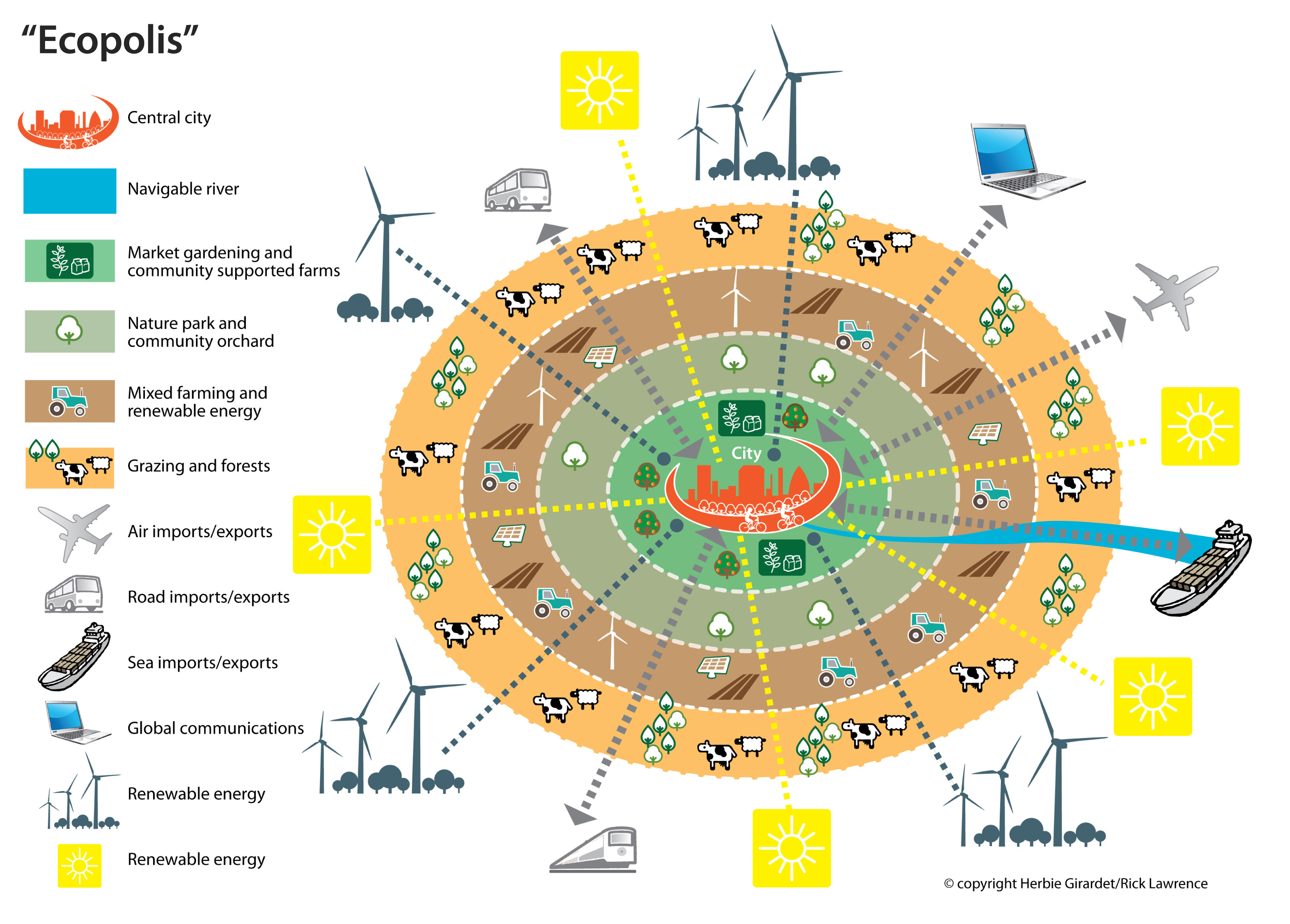
In the last few years I have written extensively about ‘Ecopolis – the Regenerative City’ in various books and articles, asking whether and how we can make human habitats that are good for people as well as for the world’s ecosystems.
Ecopolis incorporates some elements of Agropolis, the traditional town that draws its resource supplies from its local countryside. But unlike its historical successor Petropolis, Ecopolis is powered primarily by modern renewable energy systems.
Ecopolis expands the concept of urban ecology: not just focusing on the interactions of living organisms within cities, and the benefits of green spaces, but also encompassing the wider global living environment from which cities draw resources, seeking to define a regenerative relationship between cities and the world’s ecosystems.
We need to address local and global issues at the same time. First, people need green, pleasant spaces for life, work and play, free from pollution and waste accumulation; they need access to urban and peri-urban forests and farms; they need to get a chance to play their part in the new, green economy; and they also need to help assure the continuous regeneration of ecosystems beyond city boundaries on whose wellbeing they ultimately depend.
Efficiently
Ecopolis is inspired by the way in which the metabolism of the biosphere functions, as a solar-powered, zero-waste, circular system, where all outputs are continuously absorbed, regenerating its soils and invariably facilitating new growth. Could cities, as part of the technosphere, work in similar ways?
Against the background of Petropolis, so oblivious of its environmental externalities, this is certainly an uphill task. But faced with unprecedented global challenges, it seems worthwhile to map out what is necessary in order to try and expand the boundaries of what is politically possible.
In many cities across the world, elements of Ecopolis are already being implemented, particularly regarding renewable energy. Low-density suburbia in countries such as the USA and Australia, with its systemic dependence on motor cars, is well suited for a solar retrofit. Babcock Ranch in Florida is showing the way.
This new, solar-powered town with some 2,000 homes incorporates more than 700,000 solar panels. Buildings are both energy efficient and weather resistant, incorporating battery systems as insurance against energy fluctuations, and for charging electric cars.
Babcock Ranch implements the concept of ‘energy subsidiarity’, with as much renewable energy as possible supplied efficiently from as nearby as possible.
Fuel
Of course, Babcock Ranch is located in one of the richest places on Earth. But much is now happening also in poorer countries, such as Bangladesh. In the past two decades, some 6 million solar home systems have been installed there, bringing electricity for domestic lighting, TV and mobile phone charging to off-grid communities.
With the prices now significantly lower than for electricity from imported coal or gas, solar energy is on the up and up across the country.
Urban and peri-urban agriculture are another important feature of Ecopolis, against the background of growing concerns about future urban food security, with both temperatures and climate variability on the rise across the globe.
Whilst creation of green places and amenity landscapes in and around cities has often had priority over food production, could regional food supplies be revitalised? The emergence of farmers’ markets in cities all over the world seems to be a strong indicator of this.
In this context, the rise of urban farming in Havana, Cuba is a fascinating development. Before 1989 Cuba’s agricultural policy concentrated on exporting crops such as sugar and tobacco to the Soviet Union in exchange for fuel, fertilisers, pesticides and wheat.
Cultivation
But after the collapse of this trade in the 1990s, Cuba faced a food emergency, worsened by strict US sanctions. How could greater food self-reliance be secured? Soon city people took matters in their own hands.
By 1995, within Havana alone, 25,000 allotments and market gardens had emerged, growing vegetables, bananas and tree crops, tended by families and small-scale cooperatives.
The government, initially sceptical, soon encouraged this movement. Soil quality was improved with a mixture of crop residues, organic household wastes and animal manure.
The crops grown on these organopónicos quickly improved people’s calorie intake and saved many from malnutrition. Sugar is still produced on Cuba’s farmland and exchanged for rice imported from countries such as Vietnam and Ukraine, but it seems that the Cuban model of urban food self-reliance is here to stay.
Can modern cities ever become more self-sufficient in food? With competition for urban spaces in many cities, vertical cultivation inside buildings is now emerging, whereby vegetables and herbs are grown in multiple layers using both natural and LED lighting.
Renewable
There is little doubt that vertical farming will play an increasingly important role in assuring urban food supplies around the world. Because of this, vertical farming enterprises have been able to raise unprecedented amounts of funding in North America, Europe and the Middle East.
But when it comes to grains, rice and animal feed, urban farming has only limited scope, because surface areas greater than the land available in cities or outside the urban periphery are required.
Cities with heavily meat-based diets require vast land surfaces beyond local landscapes. How could the food supply to cities be decoupled from large, often distant farms?
One new option is being pursued in the labs of several companies, where researchers are developing a new generation of fermentation-based foodstuffs that require no agricultural feedstocks.
In a recent Guardian article George Monbiot explains: “The microbes they breed feed on hydrogen or methanol – which can be made with renewable electricity – combined with water, carbon dioxide and a very small amount of fertiliser.
International
"They produce a flour that contains roughly 60 per cent protein, a much higher concentration than any major crop can achieve (soybeans contain 37 per cent, chick peas, 20 per cent). When they are bred to produce specific proteins and fats, they can create much better replacements than plant products for meat, fish, milk and eggs.”
Will such new food be good for human health as well as for Nature’s health? More will be known soon.
In view of the role of cities in the Earth emergency we are facing, a plausible urban future can only mean building a regenerative relationship between cities and our host planet: it cannot cope with unending streams of pollution.
The negative externalities of our newly urban world must be addressed in effective new ways. To this end, we need to activate people’s creative energy at the local level, but also have appropriate national policy frameworks and international agreements.
Problematic
It seems only too evident that cities need to better understand their complex metabolism, yet few urban authorities seem to have an overview of these resource flows. A system of ‘green accounting’ of material flows seems crucial as a first step towards rethinking the resource balance sheet of urban businesses and public services.
Enabling the active participation of the general public in developing regenerative cities is crucially important. In Curitiba, Brazil, large public displays show how the recycling of timber and forest products has dramatically reduced the need to cut down trees. The general public need to be enabled in this way to play an active role in transforming the resource use of their cities.
To understand the metabolism of cities, we need to differentiate between the biological cycle and the technical cycle of urban systems. Whilst the recycling of paper, metals and glass is now well established in many places, technical and electronic wastes are accumulating in Nature.
And we are only just beginning to put highly problematic materials such as plastics out of harm’s way and turn them into long-lasting inert products such as fence posts and outdoor furniture.
CASE STUDIES
ADELAIDE
In 2003 I was invited to work for three months as ‘Thinker in Residence’ in Adelaide. The then premier of South Australia, Mike Rann, asked me to produce a plan for greening metropolitan Adelaide, in conjunction with city planners, community groups and the business community.
The task was to propose ways in which a highly inefficient, carbon-intensive city could be turned around, and how this could benefit the local economy.
In the mid-19th century, Adelaide had been conceived as a pioneering garden city set in 760has of parkland, covered by tens of thousands of elm and eucalyptus trees – an environment of great amenity value.
But after 1945, low-density, automobile-driven growth expanded this city into a suburban region of 1.3 million people. Commuting, consumerism and throw-away attitudes soon came to define life in Adelaide.
After 2003 remarkable things started to happen. Adelaide has become a green city of international acclaim. Above all else, the tremendous possibilities inherent in turning a highly inefficient linear urban metabolism into a circular system were recognised.
Regenerative
In 2003 there was hardly any organic waste recycling in Adelaide, but since then it has become a world leader in turning the organic waste into compost for use on nearby farmland. In conjunction with the use of recycled waste water, 20,000 ha of peri-urban farmland in a place called Virginia on the northern edge of the city supply a wonderful variety of vegetables and fruit, which is sold primarily in Adelaide’s central covered market.
To deal with deforestation, to help stabilise the soil and to counter increases in ambient temperatures, some 3 million trees have been planted in and around the city.
Metropolitan Adelaide, then, has acquired many attributes of a regenerative city. There has been a remarkable benefit from all these measures in terms of creating a new green, regenerative economy in the city. Here is a summary of the transformations that have occurred since 2003:
- More than 70 per cent of electricity produced by wind turbines and solar PV panels
- Photovoltaic roofs on 200,000 (of 600,000) houses, and on most public buildings
- Tindo, the world’s first bus running on solar energy
- Solar hot water systems mandated for new buildings
- Large-scale building tune-up programmes across the city region
- 60 per cent carbon emissions reduction by municipal buildings
- 25 per cent reduction of CO2 emissions in Greater Adelaide
- Construction of Lochiel Park Solar Village, with 106 eco-homes
- Water-sensitive urban development across the city region
- 3 million trees planted on 2,000 ha for CO2 absorption and biodiversity
- A zero-waste strategy driven by ambitious recycling incentives
- 180,000 tonnes of compost a year made from urban organic waste
- 20,000 ha of land near Adelaide used for vegetable and fruit crops
- Reclaimed waste water and urban compost used to cultivate this land
- Thousands of new green jobs
Cities in many countries are taking similarly positive initiatives, trying to decouple from a systemic dependence on fossil fuels and from reliance on global food imports while trying to create a regenerative relationship between themselves and the ecosystems beyond.
COPENHAGEN
Denmark's capital has long put sustainability at the top of its agenda, as have many of its inhabitants. A city of over 3 million people, it is a remarkable example of green innovation.
In its post-war urban plan of 1947, Copenhagen set out to develop along five ‘green fingers’, centred on commuter rail lines, which extend from the city’s ‘palm’, the dense urban fabric of central Copenhagen. In between the fingers, green wedges were created to provide land for both agriculture and recreational purposes.
In 1962, because the volume of traffic had become intolerable in its old narrow streets, a radical redesign of the heart (the palm) of the city was undertaken. Copenhagen’s city council decided to establish a car-free pedestrian zone in the maze of narrow streets and historical squares.
Today, with a total length of almost 3.2 km, it is the longest inner-city pedestrian street system in the world. This has resulted in a Mediterranean-style ambience, where markets, cafés, restaurants and green spaces proliferate.
Jobs
In Copenhagen, urban green solutions combine liveability, sustainability and regenerative development in a very effective way. Initiatives on energy efficiency, renewable energy and combined heat and power have gone further than almost anywhere in the world, and the same goes for circular waste management.
Copenhagen also has more cyclists than most other European cities, due to a highly developed network of cycle lanes. Pedestrianisation of the city centre goes hand in hand with ubiquitous cycle routes, and electric buses predominate on the city’s streets.
Recycling is taken seriously in this city, with vending-style machines returning a deposit when a can or plastic cup is inserted.
Copenhagen is now working to become the world’s first carbon-neutral capital city by 2025, with its municipal strategy combining 50 different initiatives. These have already yielded significant environmental as well as economic benefits. The green economy in the capital region has grown by 80 per cent from 2007 to 2022, generating thousands of new jobs.
NEW YORK CATSKILLS
An important point in discussing an urban future is to secure adequate and clean water supplies to cities through the protection and restoration of nearby watersheds. The detrimental effects of rapid runoff and landslides from denuded hillsides across the world have been widely reported, and the importance of watershed protection and reforestation is all too evident.
The measures initiated by New York City in the nearby Catskills watershed are a prime example. The Catskills is one of New York City’s most important natural resources, providing about 4.9 billion litres of drinking water to roughly 9 million people every day.
Because artificial filtration for that much water would have been prohibitively expensive, New York City decided to invest millions of dollars in the protection and regeneration of the watershed instead.
The Catskills, which supplies 90 per cent of New York City’s water, is the largest naturally filtered water supply in the United States, covering over 400,000 ha.
Maintaining quality standards for such a large water supply without artificial filtration requires millions of dollars each year, but most is not spent on technology, but on outreach and education, land management and acquisition, as a joint initiative between NGOs and city authorities. Large-scale forest protection initiatives like this are now being taken in various parts of the world.
THE VALUE OF ECOSYSTEM SERVICES
We cannot manage what we do not measure and we are not measuring either the value of nature’s benefits or the costs of their loss. We seem to be navigating the new and unfamiliar waters of ecological scarcities and climate risks with faulty instruments.
Replacing our obsolete economic compass could help economics become part of the solution to reverse our declining ecosystems and biodiversity loss.
We need a new compass to set different policy directions, change incentive structures, reduce or phase out perverse subsidies, and engage business leaders in a vision for a new economy. Holistic economics – or economics that recognise the value of nature’s services and the costs of their loss – is needed to set the stage for a new ‘green economy’.
Pavan Sukhdev, study leader for the report suite ‘The Economics of Ecosystems & Biodiversity’
CONCLUSION
Are there ecological limits to urban growth? So far there is not much evidence of concern about this issue, with urbanisation in many countries continuing apace.
As we look across the world, human resource consumption seems to be closely connected to the consumption patterns of an urbanising world. But we surely can’t carry on living off the Earth’s living capital rather than relying on its annual income.
It is time to move out of Petropolis and into Ecopolis. In thinking of creating regenerative cities, the full spectrum of human settlements from village to megacity needs to be considered. According to the UN, in 2016 there were 31 cities with populations of over 10 million people (megacities), and 81 cities of over 5 million.
There were 512 cities with over a million people, as compared with a single one, London, 200 years ago. These numbers are projected to rise considerably by 2030. But most of humanity still resides in settlements below that size.
In Europe most people live in cities, but the consumption patterns of people in rural areas are much the same as in urban regions: everybody goes shopping in the supermarket.
Eroded
But as human numbers continue to grow in other parts of the world, such as Africa and South Asia, urban growth is still directly linked to a substantial per capita increase in resource use, with ever more impacts on Nature.
In a world in which cities of 10 or even 20 million people are becoming common, what does that mean for the ‘ideal’ of creating regenerative cities? If the ecological footprint of London, with some eight million people, is nearly 300 times its surface area, how about Delhi, Cairo or Lagos?
And, as we see TV images of cities blanketed by smog or flooded by excessive rainfall, and see the houses of the super-rich contrasted with squatter shacks, we must ask: what does an urban future hold?
Of course, far more people must be accommodated in cities today than even 50 years ago, and this needs to be factored into developing concepts for creating human settlements fit for the 21st century. Worldwide, most buildings have yet to be constructed. Can we be sure that their design complies with the idea of regenerative cities?
Cities grow and shrink. We have many examples from history, most recently Detroit. When its economic base was eroded, with the loss of car manufacturing, hundreds of thousands of people had to go and live and work somewhere else.
Solutions
In some places gardens around parks and next to abandoned houses have been turned into urban farms. Is that what degrowth means for cities?
First and foremost, moving to Ecopolis means creating urban systems that do not rely on fossil fuels. The good news is that renewable energy can be increasingly supplied from buildings themselves, as well as from peri-urban landscapes.
And cities close to seashores can supply electricity from offshore wind farms, as we can now see in countries such as the UK. The latest wind turbines, with a capacity of up to 18 MW, can supply energy for up to 100,000 homes, and 100 turbines, in conjunction with appropriate energy storage systems, could power a megacity of 10 million people.
But we must be cautious about getting carried away with technical fixes. Getting closer to dealing with energy alternatives for our cities is now on the cards, but there is still a long way to go to deal with the linear, polluting metabolism of modern cities. It would seem that cities the size of Adelaide, with not much more than a million people, are probably best suited for green urban renewal.
Internationally, cities need to work closely together to develop and implement policies for regenerative cities, which contribute to regenerating regions across the world that have been damaged and depleted by urban consumption patterns. Our global connectedness has reached unprecedented levels, but trying to find shared solutions to the many environmental problems linked to global urbanisation has barely begun.
This Author
Professor Herbert Girardet is an author, consultant and former film-maker. He is a member of the Club of Rome, a cofounder of the World Future Council, and a recipient of a UN Global 500 award for outstanding environmental achievements. He is also a trustee of The Resurgence Trust, owner and publisher of The Ecologist online. His most recent book, Creating Regenerative Cities, was published by Routledge in 2014.
Professor Girardet is a keynote speaker at the SMALL IS THE FUTURE event hosted by The Ecologist with the Schumacher Institute in Bristol on Saturday, 17 June 2023. Tickets are selling fast - a third have already gone - so do BOOK NOW to avoid disappointment.




